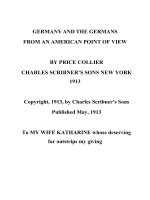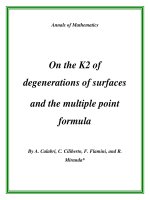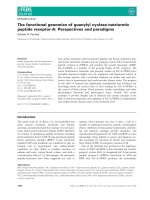learning fsharp and the functional point of view
Bạn đang xem bản rút gọn của tài liệu. Xem và tải ngay bản đầy đủ của tài liệu tại đây (767.25 KB, 41 trang )
Learning F# and the Functional
Point of View
Robert Pickering, LexiFi
Session Objectives
• Why was F# created? Why learn F#?
• A taste of the F# language
– Especially the functional side!
• A look at some wizzy features F#
Part 1
Why?
Why?
Why?
Why?
Why?
Why?
I'll let you in on a secret: I'm doing F# simply
because it's lots and lots of fun. In a very broad
sense of the word: functional programming is
fun, OO programming with F# is fun, watching
people use F# is fun.
One of the wonderful things about F# is that you
can actually end up working in your domain. In
the zone. With F#, you're not necessarily "just" a
programmer! You're likely to also be a
probabilistic modeller, or an AutoCAD engineer,
or a finance engineer, or a symbolic programmer,
or one of many other things.
- Don Syme,
F#’s creator
F# is unique amongst both imperative and
declarative languages in that it is the golden
middle road where these two extremes converge.
F# takes the best features of both paradigms and
tastefully combines them in a highly productive
and elegant language that both scientists and
developers identify with. F# makes programmers
better mathematicians and mathematicians
better programmers.
- Eric Meijer,
Forward to Expert F#
Functions are much easier to test than
operations that have side effects. For these
reasons, functions lower risk.
Place as much of the logic of the program as
possible into functions, operations that return
results with no observable side effects.
- Domain Driven Design,
Eric Evans
F# frees you of the fluffy
pink hand cuffs of C#
- Amanda Laucher,
Consultant and F# Author
F# - What is it For?
• F# is a General Purpose language
• F# is also “A Bridge Language”
– “A Language Both Researchers and Developers
Can Speak”
• Some important domains
– Scientific data analysis
– Data mining
– Domain-specific modeling
F#: The Combination Counts!
F#
Statically
Typed
Succinct
Scalable
Libraries
Explorative
Interoperable
Efficient
F#: Influences
OCaml C#/.NET
Similar core
language
Similar object
model
F#
Part 2
F# the Language
and the Functional
Point of View
Hello World
printfn "hello world"
Values & “let” Bindings
let anInt = 42 // an integer
let aString = "Stringy" // a string
let aFloat = 13. // a float
let aList = ["Collect"; "ion"]
// a list of strings
let aTuple = "one", 2 // a tuple
let anObject = new FileInfo(@"c:\src.fs")
// a .NET object
// a function
let addTen = fun x -> x + 10
Functions
// shorter version
let addTen x = x + 10
// multi parameters and
// intermediate results
let addThenTimesTwo x y =
let result = x + y
result * 2
Function as Values
// define a list
let list = [1; 2; 3]
// define a function
let addNine x = x + 9
// pass function to "addNine" to
// higher order function "List.map"
let result = List.map addNine list
Anonymous Functions
// define a list
let list = [1; 2; 3]
// pass function definition directly to
// higher order function "List.map"
let result =
List.map (fun x -> x + 9) list
Everything’s an Expression
let name , value =
if useFirst then "Robert" , 1
else "Pickering", 2
// bind name to "Robert"
// or to "Pickering"
let name =
if useFirst then "Robert"
else "Pickering"
let myTuple =
// we can bind more than one value at once
Loop With Recursion
let cMax = complex 1.0 1.0 // Max complex value
let cMin = complex -1.0 -1.0 // Min complex value
let iterations = 18 // Max iterations
let isInMandelbrotSet c0 =
let rec check n c =
(n = iterations) // exit if max iterations
// reached
|| (cMin < c) && (c < cMax) // exit if escaped
// complex number bounds
&& check (n + 1) ((c * c) + c0) // recurse !
// start recursion
check 0 c0
Record Types
// a "Person" type definition
type Person =
{ FirstName: string;
LastName: string; }
// an instance of a "Person"
let aPerson =
{ FirstName = "Robert";
LastName = "Pickering"; }
Creating New Records
// a single person
let single =
{ FirstName = "Robert";
LastName = "Pickering"; }
// create record with different
// last name
let married =
{ single with
LastName = "Townson"; }
Union Types – The Option Type
// The pre-defined option type
type Option<'a> =
| Some of 'a
| None
// constructing options
let someValue = Some 1
let noValue = None
// pattern matching over options
let convert value =
match value with
| Some x -> Printf.sprintf "Value: %i" x
| None -> "No value"
Union Types - Trees
// a binary tree definition
type BinaryTree<'a> =
| Node of BinaryTree<'a> * BinaryTree<'a>
| Leaf of 'a
// walk the tree collection values
let rec collectValues acc tree =
match tree with
| Node(ltree, rtree) ->
// recursively walk the left tree
let acc = collectValues acc ltree
// recursively walk the right tree
collectValues acc rtree
| Leaf value -> value :: acc
// add value to accumulator
Using the Tree
// define a tree
let tree =
Node(
Node(Leaf 1, Leaf 2),
Node(Leaf 3, Leaf 4))
// recover all values from the leaves
let values = collectValues [] tree
.NET Objects
open System.Windows.Forms
let form =
// create a new form instance
let form = new Form(Text = "Hello")
// create a couple of controls
let textBox = new TextBox(Text = "Hello")
// add the controls
form.Controls.Add(textBox)
// return the form
form
form.Show()
Part 3
A brief look at









